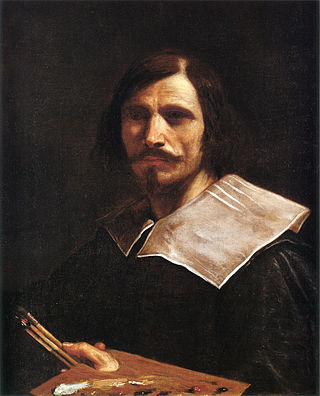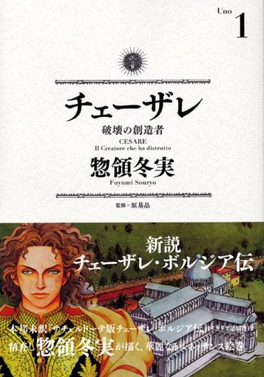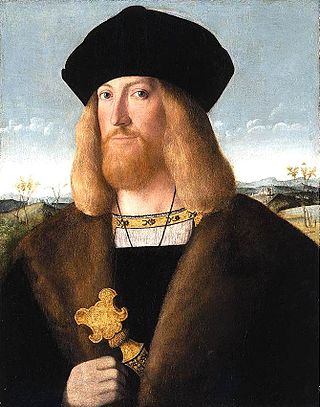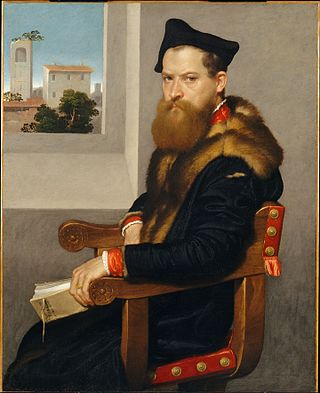
Cesare Borgia was an Italian cardinal and condottiero, an illegitimate son of Pope Alexander VI and member of the Spanish-Aragonese House of Borgia. His fight for power was a major inspiration for The Prince by Niccolò Machiavelli.

Leonardo di ser Piero da Vinci was an Italian polymath of the High Renaissance who was active as a painter, draughtsman, engineer, scientist, theorist, sculptor, and architect. While his fame initially rested on his achievements as a painter, he has also become known for his notebooks, in which he made drawings and notes on a variety of subjects, including anatomy, astronomy, botany, cartography, painting, and palaeontology. Leonardo is widely regarded to have been a genius who epitomised the Renaissance humanist ideal, and his collective works comprise a contribution to later generations of artists matched only by that of his younger contemporary Michelangelo.

Lucrezia Borgia was an Italian noblewoman of the House of Borgia who was the illegitimate daughter of Pope Alexander VI and Vannozza dei Cattanei. She reigned as the governor of Spoleto, in her own right, a position usually held by Cardinals.

Giovanni Francesco Barbieri, better known as (il) Guercino, was an Italian Baroque painter and draftsman from Cento in the Emilia region, who was active in Rome and Bologna. The vigorous naturalism of his early manner contrasts with the classical equilibrium of his later works. His many drawings are noted for their luminosity and lively style.

Giovanni di Niccolò de Luteri, better known as Dosso Dossi, was an Italian Renaissance painter who belonged to the School of Ferrara, painting in a style mainly influenced by Venetian painting, in particular Giorgione and early Titian.

The House of Borgia was a Spanish noble family, which rose to prominence during the Italian Renaissance. They were from Xàtiva, Kingdom of Valencia, the surname being a toponymic from the town of Borja, then in the Crown of Aragon, in Spain.

Giovanni Battista Moroni was an Italian painter of the Mannerism. He also is called Giambattista Moroni. Best known for his elegantly realistic portraits of the local nobility and clergy, he is considered one of the great portrait painters of the Cinquecento.

Altobello Melone was an Italian painter of the Renaissance.
Events from the year 1543 in art.

Prince of Foxes is a 1949 American historical adventure film adapted from Samuel Shellabarger's novel Prince of Foxes. The movie starred Tyrone Power as Orsini and Orson Welles as Cesare Borgia. It was nominated for two Oscars during the 22nd Academy Awards: Best Black and White Cinematography and Best Costume Design, Black and White.
James H. Beck was an American art historian specializing in the Italian Renaissance. He was an outspoken critic of many high-profile restorations and re-attributions of artworks, and founded the pressure group ArtWatch International to campaign against irresponsible practices in the art world.

Cesare: Hakai no Sōzō-sha, also known as Cesare: Il Creatore che ha distrutto, is a Japanese historical manga series written and illustrated by Fuyumi Soryo. The story follows the early life of Cesare Borgia, a 15th-century Italian aristocrat, politician, and mercenary leader. In creating Cesare, Soryo collaborated with Dante scholar Motoaki Hara to bring Renaissance Italy to life in great and accurate detail. The manga was serialized in Kodansha's seinen manga magazine Morning from March 2005 to November 2021 and collected into 13 tankōbon. The manga also inspired a stage musical adaptation, which was canceled before its debut in April 2020 due to the COVID-19 pandemic. Instead, a live concert was held in July 2020. The musical was finally performed in January and February 2023.

Bartolomeo Veneto was an Italian painter who worked in Venice, the Veneto, and Lombardy. During his time in Venice, he studied under Gentile Bellini. The little information available about Bartolomeo's life has been derived from his signatures, dates, and inscriptions. His best-known works are portraits or pictures with portrait-like character. Bartolomeo's later works, and especially those done on commission in Milan, indicate an influence from the artist Leonardo da Vinci.

A Man with a Quilted Sleeve is a painting of about 1510 by the Venetian painter Titian in the National Gallery, London, measuring 81.2 by 66.3 centimetres. Though the quality of the painting has always been praised, there has been much discussion as to the identity of the sitter. It was long thought to be a portrait of Ariosto, then a self-portrait, but since 2017 has been called Portrait of Gerolamo (?) Barbarigo by the gallery, having also been called merely Portrait of a Man, the title used here, The Man with the Blue Sleeve, and no doubt other variants.

Assassin's Creed Identity is an action-adventure video game developed by Ubisoft Blue Byte and published by Ubisoft. It is a spin-off installment of the Assassin's Creed series, and takes place alongside the events of Assassin's Creed: Brotherhood. In the game, players assume the role of a customisable Assassin known as Lo Sparviero and carry out various missions in Italy to weaken the control of the Templar Order, led by the villainous Borgia family. The main storyline revolves around the Assassins' conflict with a mysterious organization known as "the Crows", who can perfectly mimic their skills and techniques.
Fran Lew is an American master portrait artist. She is a contemporary realist, trained in academic classical realism. Lew's style of portraiture combines traditional techniques of the Old Masters with her own contemporary vision.

The Portrait of Bartolomeo Bonghi is an oil on canvas portrait by Italian artist Giovanni Battista Moroni, created in 1553. It is held at the Metropolitan Museum of Art, in New York. It depicts Bartolomeo Bonghi, a 16th-century Italian legal scholar. The portrait presents its subject as he was in life; a man of wealth and status. The buildings seen in the top left-hand corner of the painting identify the site of the portrait's sitting as Bergamo in Lombardy.

Count Guglielmo Lochis was an Italian nobleman, politician, art collector and art connoisseur.

The Portrait of Alessandro Vittoria is an oil on canvas painting created by Italian painter Giovanni Battista Moroni, in 1551–1552. It is held at the Kunsthistorisches Museum, in Vienna.

The Portrait of a Man Holding a Letter, also known as The Lawyer, is an oil on canvas painting by Italian painter Giovanni Battista Moroni, from 1570-1572. It is held at the National Gallery, in London. It is considered one of the most representative paintings of the artist's maturity.

















